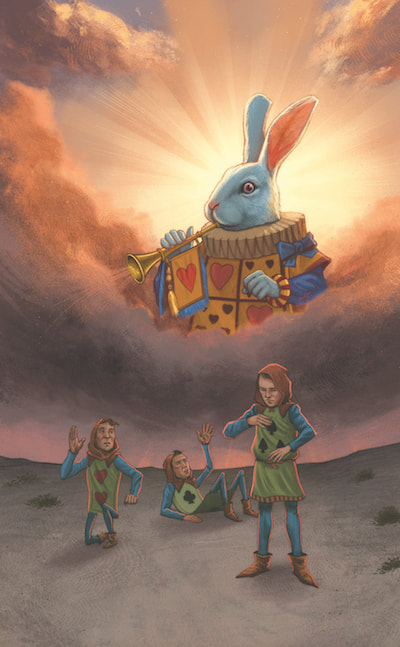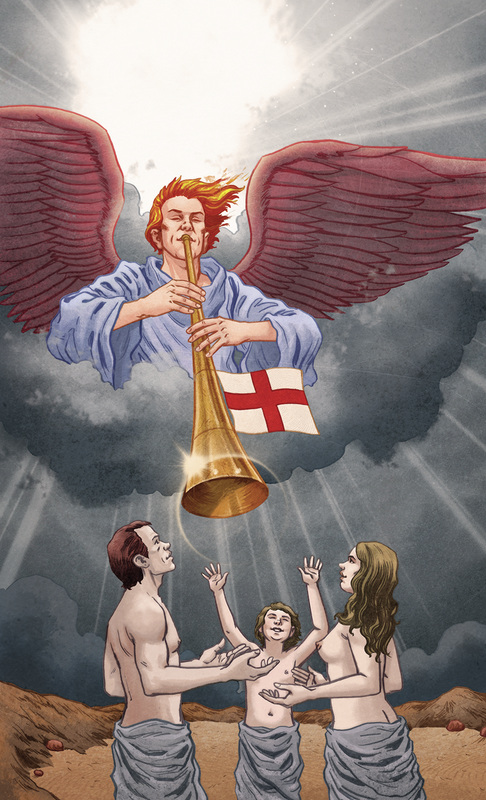|
One of the interesting aspects of creating this is that it is not “an Alice in Wonderland” deck. In other words, it is not made by matching scenes from the stories to the cards. It is truly Tarot in Wonderland…and (as the book is called) Wonderland in Tarot. The images come from the place where these two sacred texts meet and mingle. Sometimes, if appropriate, the scenes are directly from the stories. At other times, the characters from the stories find themselves in tradition tarot card scenes.
Judgement is one of those cards whose image isn’t from the story but rather a blending of Wonderland and tarot. XX, Judgement Through the Looking Glass Like several other cards in the tarot deck, this one could do with a new name. “Judgement” as a name implies being judged. In addition, the traditional imagery—angel sounding a horn and dead people rising from their graves—suggests the biblical story of the Last Judgment, where all people, living and dead, would be judged. Maybe centuries ago the card was interpreted in this way. However, as human consciousness evolves, so too does our understanding of the cards. It is now more common to recognize that this card is a gift and an opportunity. In Wonderland, particularly in Tenniel’s iconic illustrations, the playing card people (other than the royalty cards) are shown as flat, as if they are actually made of cardstock. In some ways, they are metaphors for two-dimensional people. In this image, they hear the White Rabbit’s trumpet. As they respond, they find themselves filling out and, like Pinocchio, becoming real three-dimensional people. They are, in short, coming to life…or more accurately to new life, since they were already alive in some sense of the word. The White Rabbit in the sky takes the place of the tradition angel. In Wonderland, he plays the role of herald during the Knave of Heart’s trial. Heralds were, among other things, the messengers of the nobility. They were sometimes experts in law or known for giving moral guidance, which explains why, in the text, the Rabbit is able to take control of the proceedings of the trial, even to the point of contradicting the king. He was a voice that represented an order that was higher than earthly jurisdiction. During the trial, Alice waits, curious about the next witness to be called. “Imagine her surprise, when the White Rabbit read out, at the top of his shrill little voice, the name ‘Alice!’” When she takes the stand, the story reaches its climax and ends with Alice asserting her will and her sense of what is meaningful in the face of nonsense and violence. The White Rabbit did not only call Alice to the stand; he called her to become the person she knew she should be. Down the Rabbit Hole In a reading, Judgement marks an invitation to hear a higher voice, perhaps your preferred deity or your own higher self, and follow its call. You have the opportunity to leave behind an old life and embrace a new way of living. Humans, though, are resistant to change and try to ignore this call, especially if their old life was not so bad. It is even harder to change your ways if your current life is actually good and comfortable. Plus, answering this call means a kind of death, since you will be leaving some parts of you, some behaviors, some beliefs behind. A call like this, though, resonates deeply in the heart and unless you shut down your heart entirely, you won’t be able to resist it forever. After you begin living in this new way, when you look back on your old life, you will see that it was a kind of half life, a cardboard life, a life lacking depth and dimension. Keywords: rebirth, renewal, rite of passage, calling, vocation, awakening, change, decision, forgiveness, redemption, absolution, judgment To pre-order from Amazon, click the picture below!
0 Comments
This morning I listened to a Good Life Project Riff (short podcasts that briefly explore a subject) called What if You Were Defined by Your Worst Moment? You can listen to it HERE. I suggest you do, because it is really good and under six minutes.
I've seen too many relationships, beautiful, loving, nurturing relationships or reputations thrown away or destroyed, because one person made a mistake. As Jonathon says in the podcast, a lifetime of loving, kind acts can be erased by one moment of reaction, stress, anger, or other human emotion. He posits and I agree, that we do better (and are making a more accurate judgment) to look at the long haul, the cumulative goodness as the norm and the one thing, the one mistake, as an anomaly and part of being human. And you must know, I'm talking about mistakes and not talking about things like assault and such. Nor am I talking about reasonable discernment. He turns the question on us: how would our characters be described if someone used only our worst moment? How accurate would it be? Not very, I bet. So why are we so quick to think that one mistake means we need to say "Aha! They've shown their true colors and now I will never trust them again!" We, or at least I, do this to myself as well. One mistake and I think of myself as some lame loser who has never had one bit of value. Or maybe something less extreme, but still, pretty hateful and unrealistic. I don't know why we do this. Maybe because it makes life easier in some ways. We like things simple and black and white. Rules help make things easier and just cutting a person off is a lot easier than working through emotional messes. Maybe next time you find yourself judging yourself or someone else, first measure that thought against the idea of judgment being a way to give life rather than crush life. Image: Judgement from Llewellyn's Classic Tarot, by Barbara Moore and Eugene Smith |
Categories
All
Archives
September 2023
|



 RSS Feed
RSS Feed